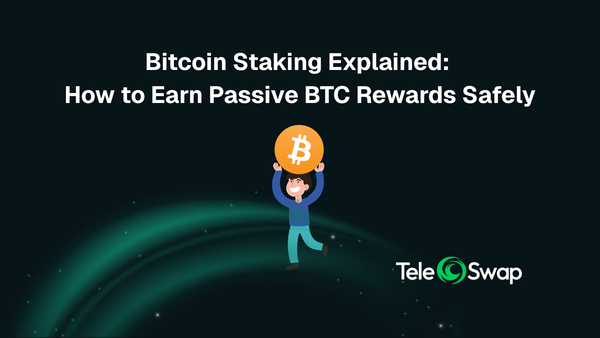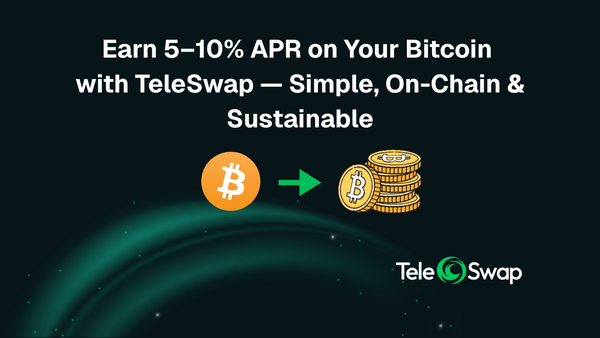Best Ways to Earn Passive Income with Bitcoin in 2025

Introduction
Holding Bitcoin (BTC) by itself won’t earn you any interest or dividends – it’s like digital gold sitting idle in a vault. BTC runs on its own blockchain without native support for smart contracts or staking, so simply owning BTC doesn’t generate yield. To start earning passive income with Bitcoin, you need to put your BTC to work in decentralized finance (DeFi). This became possible thanks to Wrapped Bitcoin (WBTC) – an ERC-20 token on Ethereum that’s pegged 1:1 to BTC, allowing Bitcoin’s value to be used in Ethereum’s DeFi ecosystem In simple terms, each WBTC represents one BTC held in reserve, giving BTC holders a gateway to earn yield through Ethereum-based protocols without selling their Bitcoin.
By bridging BTC to WBTC, while still allowing Bitcoin holders to do so, they can access lending platforms, liquidity pools, and other DeFi applications to earn interest, fees, and rewards. TeleSwap notes that wrapping BTC for DeFi “lets you enjoy attractive yields” on Ethereum, while still allowing you to reclaim native BTC when you want. It’s no surprise that billions of dollars’ worth of BTC have flowed into DeFi via WBTC and similar tokens. In 2024, the total value locked of Bitcoin on DeFi platforms reached over $10 billion, reflecting the huge demand to earn yield on Bitcoin holdings
In this article, we’ll explain why converting BTC to WBTC is the crucial first step to earning yield, then cover the best strategies to earn yield with BTC in DeFi (from lending and liquidity provision to staking and collateralization). We’ll also discuss how to bridge WBTC back to BTC when you want to “unwrap,” and the key risks and considerations to keep in mind. Let’s dive into how you can finally make your Bitcoin work for you in 2025.
Bridging BTC to WBTC: The First Step Toward Yield
To put your Bitcoin to work in DeFi, the first step is to bridge BTC to WBTC. Bridging means converting your native BTC on the Bitcoin network into Wrapped BTC on Ethereum (i.e. “wrapping” it). When you do this, a custodian holds your BTC and mints an equivalent amount of WBTC on Ethereum. Each WBTC is pegged 1:1 with Bitcoin, so you still effectively own BTC,, just in tokenized form that’s usable in smart contracts. This step is essential because Bitcoin’s network can’t interact with DeFi apps, but Ethereum (and other smart contract chains) can. By wrapping BTC into WBTC, you’re able to deploy your BTC in lending platforms, decentralized exchanges (DEXs), yield farms, and more, unlocking opportunities to earn passive income that pure BTC cannot
Why bridge BTC to WBTC,? If you hold BTC but want to earn interest or fees in DeFi, converting to WBTC is a must. For example, you can’t lend out native BTC on Ethereum’s Aave or trade it on Uniswap – but you can do those with WBTC. In exchange for this flexibility, you’ll pay a small conversion fee and trust the WBTC custodial system to hold your BTC reserve. Historically, wrapping BTC involved centralized services: either depositing BTC to a centralized exchange (CEX) and swapping for WBTC, or going through an official WBTC merchant/custodian with lengthy processes and KYC requirements. These methods worked but had drawbacks like relinquishing custody, slow processing, and sometimes hefty fees.
Today, platforms like TeleSwap make bridging much easier. TeleSwap’s decentralized BTC–WBTC bridge lets you swap between BTC and WBTC in one click, without any centralized intermediary. There’s no account or KYC needed – you simply connect your wallet and swap. Your BTC never goes through a custodial exchange; instead, the swap is done via audited smart contracts and a cross-chain mechanism (TeleportDAO) that keeps you in control of your keys. The result is that your WBTC is delivered directly to your Ethereum wallet (when wrapping) or your BTC is delivered to your Bitcoin address (when unwrapping), with no middlemen holding your funds along the way. TeleSwap also optimizes for low cost – it charges only about a 0.1% protocol fee to bridge, which is significantly lower than many alternatives (some exchanges or bridges hide higher fees in their rates. TeleSwap’s trustless bridge can often complete a BTC↔WBTC swap in just 3–5 minutes, whereas using a CEX might take 30+ minutes by the time you deposit, trade, and withdraw. In short, bridging BTC to WBTC is now a quick, trust-minimized process – a crucial first step to start earning yield on your Bitcoin.
(For a detailed primer on WBTC and how it differs from native BTC, check out our What is WBTC and how does it differ from Native BTC article.)
Top Strategies to Earn Passive Income Using WBTC
Once you’ve wrapped your Bitcoin into WBTC, you can deploy it across DeFi platforms to generate yield. Here are some of the best ways to earn passive income with WBTC in 2025:
- Lending WBTC on DeFi Platforms: One of the simplest strategies is to deposit your WBTC into a lending protocol (money market) like Compound, Aave, or MakerDAO. These platforms let others borrow your WBTC, and in return, you earn interest. The interest rate varies with market demand, but it’s typically a few percent annually, paid in kind (you accumulate more WBTC over time). For example, supplying WBTC to a lending pool might earn around ~3% APY in interest under normal market conditions. On top of interest, some platforms also distribute governance tokens as rewards – for instance, Compound gives out COMP tokens to lenders, which can boost your overall yield. Lending is generally a low-effort, lower-risk way to earn yield with BTC because your WBTC remains as collateral in a well-audited protocol, and you can withdraw it (plus accrued interest) anytime. It essentially lets you earn yield with BTC passively, similar to earning interest in a savings account, but using decentralized protocols.
- Providing Liquidity on Decentralized Exchanges: Another popular avenue is to provide your WBTC as liquidity on DEXs like Uniswap, SushiSwap, or Balancer. Typically, you would supply WBTC paired with another asset (common pairs include WBTC/ETH or WBTC/stablecoin) into a liquidity pool. In return, you earn a share of the trading fees whenever traders swap those assets via the pool. This can be lucrative if the pool has high volume – for example, trading fees might net you a few percent to double-digit APY over a year, depending on activity. During periods of high demand or extra incentives, liquidity providers in WBTC pools have seen double-digit annual yields, sometimes upwards of 10–20% APY in competitive pools. Additionally, many DEXs or DeFi projects offer liquidity mining rewards: you might earn the DEX’s native token (e.g., UNI, SUSHI) on top of fees, further increasing your earnings. Providing liquidity effectively puts your BTC to work facilitating trades – your passive income comes from the fees and rewards. Important: Liquidity provision does expose you to impermanent loss (explained in the Risks section below), which can reduce your profitability if BTC’s price moves significantly. Many WBTC providers mitigate this by choosing pools with relatively stable counterpart assets or by actively managing their positions. Still, liquidity provision has proven to be a rewarding strategy for those who understand and manage the risks.
- Staking WBTC in Yield Farms and Vaults: “Staking” WBTC can refer to various yield-farming arrangements where you lock your WBTC into a smart contract to earn rewards. For example, you might stake WBTC in a yield farm that pays out a project’s token, or deposit WBTC into an automated yield vault like those offered by Yearn Finance or BadgerDAO. In yield farms, your WBTC (sometimes combined with another token) could earn high reward APRs, especially for new DeFi projects incentivizing liquidity. Yield vaults, on the other hand, automatically deploy your WBTC into multiple strategies to maximize return – for instance, a vault might put WBTC into a Curve pool, earn trading fees and CRV tokens, sell those rewards for more BTC, and compound your gains. These automated vaults let you earn yield without micromanaging the process. Projects like BadgerDAO specialize in earning yield on tokenized Bitcoin and offer “set-and-forget” vaults for WBTC. By staking your WBTC in such vaults, you can earn passive income on Bitcoin in a very hands-off way – the vault handles the strategy, and you simply withdraw more WBTC than you deposited after some time. Just be aware that yield farming often comes with higher risk (smart contract risk, reward token volatility, etc.), so it’s wise to use reputable platforms. Nonetheless, for many crypto-savvy BTC holders, staking WBTC in DeFi yield farms can significantly outperform just holding BTC, especially in bull markets where yield opportunities abound.
- Using WBTC as Collateral for Loans: WBTC can also be used as collateral to borrow other assets – this is a way to unlock liquidity from your Bitcoin without selling it. For instance, on MakerDAO, you can lock WBTC in a vault and borrow DAI stablecoins, or on Aave, you can borrow ETH or USDC against your WBTC. By doing so, you maintain your BTC exposure (since you still hold the WBTC as collateral) while getting access to cash or other crypto that you can then reinvest for yield. Some users employ this strategy to, say, borrow stablecoins with WBTC and then lend those stablecoins out for interest or deploy them in yield farms – effectively earning yield on two fronts. Using WBTC as collateral is a form of leveraging your BTC holdings: you can earn additional returns with the borrowed funds, but you must manage the loan carefully. The big benefit here is you don’t have to liquidate your long-term BTC position to access capital; you can preserve your upside in BTC. DeFi platforms like Maker, Compound, and Aave allow Bitcoin holders to “lock up their Bitcoin (via WBTC) to borrow stablecoins or other assets”, providing liquidity without selling their BTC. This strategy can enhance your overall returns (for example, earn 5% on a stablecoin yield farm while still holding your BTC), but it comes with the risk of liquidation – if BTC’s price falls too much, your collateral might be sold by the protocol to repay your loan (more on that in Risks). As long as it’s used prudently (e.g., borrowing a conservative amount against your WBTC and monitoring your loan), collateralizing WBTC can be an effective way to put idle BTC value to productive use.
Each of these strategies lets you earn yield with BTC in different ways – whether through interest, trading fees, reward tokens, or capital efficiency. Many users diversify across several strategies to balance the risk/reward. For example, you might lend a portion of your WBTC for steady interest while using another portion in a higher-yield liquidity pool. The key is to choose what fits your risk tolerance and to use platforms you trust. Now that we’ve covered how to earn passive income using WBTC, let’s look at how you can convert back to native BTC when needed, and then the risks you should watch out for.
Bridging WBTC back to BTC: When and How to Unwrap
After earning yield in DeFi with WBTC, you may eventually want to bridge WBTC to BTC – in other words, convert your Wrapped Bitcoin back into native Bitcoin. There are several reasons to do this “unwrapping.” You might want to take profits and hold BTC in cold storage, use your BTC for payments on the Bitcoin network, or simply exit DeFi positions and return to the safety of BTC’s base layer. Unwrapping WBTC gives you back full custody of Bitcoin on its own blockchain. Because WBTC is meant to be 1:1 redeemable with BTC, bridging back is usually straightforward, but the method you choose matters for speed, cost, and trust.
Traditionally, converting WBTC to BTC meant going through a centralized route. One option was to send your WBTC to a major exchange (like Coinbase or Binance), trade it for BTC, and then withdraw the BTC to your wallet. This works, but it involves multiple steps and handing custody to the exchange during the process. Another traditional route is using WBTC’s official custodial partners: you would request to redeem WBTC via a merchant (which requires KYC verification and a waiting period), the custodian (e.g. BitGo) would then release actual BTC to you and burn the corresponding WBTC. This custodial redemption is tedious for retail users and is usually only done for large amounts or in institutional contexts. In both cases, you’re relying on intermediaries and giving up some control.
TeleSwap offers a better way to unwrap. As mentioned earlier, TeleSwap is a decentralized bridge that lets you swap WBTC directly for BTC (and vice versa) without a centralized exchange or custodian in the middle. Using TeleSwap, you can convert WBTC back to BTC in a single transaction. You just specify the Bitcoin address where you want to receive BTC, send your WBTC from your Ethereum wallet into the swap, and the protocol handles the rest. There’s no KYC or account signup required – you remain anonymous and in control of your coins throughout the process. The swap is atomic and trustless, meaning it either successfully delivers your BTC or the transaction doesn’t execute, so you don’t have to worry about your funds getting stuck. Many users choose TeleSwap to unwrap because it’s fast (often a few minutes) and cost-efficient (just a ~0.1% fee, plus network fees). Compared to withdrawing from a CEX (which might charge higher fees and take more time), TeleSwap lets you regain native BTC with minimal hassle.
In summary, when you’re done using WBTC in DeFi and want to go back to Bitcoin, you can simply perform a WBTC→BTC swap through a trustless bridge like TeleSwap. This way, you get your real BTC in your own wallet quickly, without giving up custody or paying excessive fees. It’s an ideal solution if you value self-custody and privacy. Of course, you can also unwrap via other methods if you prefer, but whichever way you choose, it’s good to plan your exit strategy in advance, especially if market conditions are volatile. (If you’d like a step-by-step walkthrough on converting WBTC to BTC, check out our How to Bridge WBTC to BTC Without a Centralized Exchangea guide for detailed instructions.)
Risks and Considerations
Earning yield with Bitcoin through WBTC is powerful, but it comes with important risks and considerations. Before diving in, make sure you understand the following:
- Custodial Risk (WBTC Trust): Unlike native BTC, WBTC involves trust in a custodial system. Every WBTC token is backed by real BTC held by custodians (primarily BitGo, managed by the WBTC DAO merchants). This introduces counterparty risk – you rely on those entities to securely hold the BTC reserves and honor redemptions. If a custodian were to fail, be hacked, or mismanage funds, WBTC could lose its 1:1 peg. In other words, WBTC is only as secure as the institutions and smart contracts backing it. To date, WBTC has maintained a solid track record with regular audits and proof of reserve checks, but the risk isn’t zero. You should be aware that wrapping Bitcoin means adding a layer of trust. Always obtain WBTC through reputable services and keep an eye on the WBTC reserve status (which is publicly verifiable). TeleSwap’s bridge helps minimize additional trust assumptions when swapping (using decentralized escrow addresses and scripts), but even TeleSwap ultimately relies on the WBTC token maintaining its peg. Bottom line: Custodial risk is the price of admission for using BTC in DeFi – consider it carefully and don’t put more BTC into WBTC than you’re comfortable wrapping.
- Smart Contract & Platform Risk: When you move into DeFi, you’re trusting smart contracts and protocols with your assets. Smart contract risk is the danger that a bug or vulnerability in a platform’s code could be exploited, leading to a loss of funds. Even well-established protocols have suffered hacks or failures in the past. In 2024 alone, over $2.2 billion worth of cryptocurrency was stolen in hacks – a large portion of that via DeFi exploits. If you deposit WBTC into a lending pool or DEX, you face the risk that a flaw (or an oracle failure, etc.) could result in your funds being drained. To mitigate this, stick to reputable, audited protocols that have been battle-tested (for example, Aave, Uniswap, and Compound have proven security track records). Diversify across platforms to avoid single points of failure. And always remember the DeFi mantra: never invest more than you can afford to lose. While the goal is to earn passive income, that income is not free – it comes with the implicit insurance cost of these risks. Using trust-minimized tools like TeleSwap can eliminate some risks (e.g., you don’t have to trust a centralized exchange’s security when bridging), but once your WBTC is in DeFi, smart contract risk is unavoidable. Stay informed about platform updates, and consider protective measures like bug bounty coverage or withdrawal at any sign of trouble.
- Impermanent Loss (Liquidity Provision Risk): If you provide WBTC to a liquidity pool (paired with another asset), you must understand impermanent loss (IL). Impermanent loss occurs when the price of the assets in the pool changes relative to each other from the time you deposited them. This can cause the value of your share of the pool to be less than what it would have been if you simply held the assets outside the pool. In the context of WBTC, suppose you add liquidity to a WBTC/ETH pool. If BTC’s price rises sharply against ETH, the pool’s algorithm will automatically rebalance, meaning you’ll end up with more ETH and less WBTC (since the pool sells some of your BTC for ETH to maintain the ratio). You could wind up with a lower total BTC value than if you had just held your BTC. This loss is called “impermanent” because if prices return to the original ratio, the loss diminishes. However, if you withdraw liquidity while the price gap is large, the loss becomes permanent (realized). IL is an inherent risk of liquidity mining – sometimes the trading fees and rewards you earn will offset it, but not always. Pools with volatile asset pairs (like WBTC paired with a volatile altcoin) are especially prone to IL. You can mitigate this by choosing pools with either correlated assets (e.g., WBTC with another form of BTC, or WBTC with renBTC/tBTC, etc.) or by actively monitoring and withdrawing if IL gets severe. Some newer AMM designs and coverage services aim to reduce IL, but it remains a key consideration. Always factor in potential impermanent loss when calculating your true returns from liquidity provision – the highest APY pools often have significant IL risk in the background.
- Liquidation and Volatility Risks: When using WBTC as collateral for loans (or any leveraged strategy), you introduce the risk of liquidation. If the value of your WBTC collateral falls below a certain threshold relative to your loan, the protocol will liquidate your position, meaning your WBTC could be sold off (often at a discount) to repay the debt. For example, on MakerDAO, a common collateralization ratio for WBTC is 150% – if your collateral value drops near that level, your vault can be liquidated. Bitcoin is known for price volatility, so a sharp downturn (or even a sudden flash crash) can trigger liquidations if you’re not careful. To manage this, maintain a healthy buffer: don’t borrow the maximum amount; instead, keep your collateralization well above the minimum (e.g., 200% or more) to withstand price swings. It’s also wise to monitor your loan and be ready to add more collateral or repay some debt if BTC’s price drops significantly. Aside from liquidation risk, remember that your yield is variable and subject to market conditions. Interest rates on WBTC lending can change quickly, DeFi reward token prices can fluctuate (affecting your yield farming ROI), and of course, BTC’s own price movement will influence the value of your earnings. Earning a 5% yield doesn’t help if Bitcoin’s price drops 20% in that time – you still have overall exposure to the crypto market. Thus, treat these strategies as a way to enhance your BTC holdings, not a guaranteed profit. Manage risk by keeping some unencumbered BTC on the side, and use tools like stop-loss triggers or notifications for your positions where possible.
In summary, do your homework on risks before chasing yield on your Bitcoin. The most common pitfalls – custodial risk, smart contract exploits, impermanent loss, and liquidation – can be managed with due diligence and prudent strategy. Diversify across platforms, use reliable services, and keep an eye on your positions. The goal is to earn extra BTC or income, not to lose your hard-earned Bitcoin by being careless. If you approach Bitcoin DeFi with respect for the risks, you’ll be in a much better position to profit safely.
Conclusion: Put Your Bitcoin to Work with WBTC using TeleSwap
Bitcoin may be the ultimate “HODL” asset, but in 2025, you no longer have to let it just sit in your wallet doing nothing. By bridging to WBTC and leveraging DeFi, you can earn passive income with Bitcoin through interest, trading fees, and rewards – all while still maintaining your BTC exposure. We covered how bridging BTC to WBTC is the first step that unlocks Bitcoin’s participation in DeFi, and we explored top yield-generating strategies ranging from simple lending to providing liquidity and yield farming. We also discussed unwrapping back to BTC: when the time comes to return to the Bitcoin network, TeleSwap’s trustless bridge makes bridging WBTC to BTC easy and seamless. Just remember that with opportunity comes risk, so always consider the custodial and DeFi risks before diving in.
If you’re ready to put your BTC to work, a great place to start is by using TeleSwap – a decentralized bridge that lets you convert BTC to WBTC and vice versa in a matter of minutes. With TeleSwap’s trustless BTC↔WBTC bridge, you can swap Bitcoin into WBTC with no middlemen and start earning yield with your BTC in DeFi right away. And whenever you want to unwrap, TeleSwap will swap your WBTC back to native BTC and send it straight to your wallet, no exchange required. Check out our detailed guide How to Bridge WBTC to BTC Without a Centralized Exchange for a step-by-step tutorial on using TeleSwap to convert between BTC and WBTC. You may also find our article What is WBTC, and how does it differ from Native BTC useful for understanding the fundamentals of wrapped Bitcoin and its role in DeFi.
By taking advantage of WBTC and DeFi platforms, you can transform Bitcoin from a static asset into a productive one. Whether it’s earning interest on Aave or compounding rewards in a BadgerDAO vault, there are many options to grow your BTC stack. Just be sure to stay safe: stick to reputable protocols, keep your security hygiene strong, and never over-leverage. Bitcoin in DeFi is an exciting frontier that merges the reliability of BTC with the innovation of decentralized finance. With the right strategy and tools like TeleSwap at your disposal, you can earn yield with BTC and build your holdings over time – all while retaining the freedom to return to the Bitcoin network whenever you choose. Happy earning, and welcome to the world of Bitcoin-powered DeFi!




